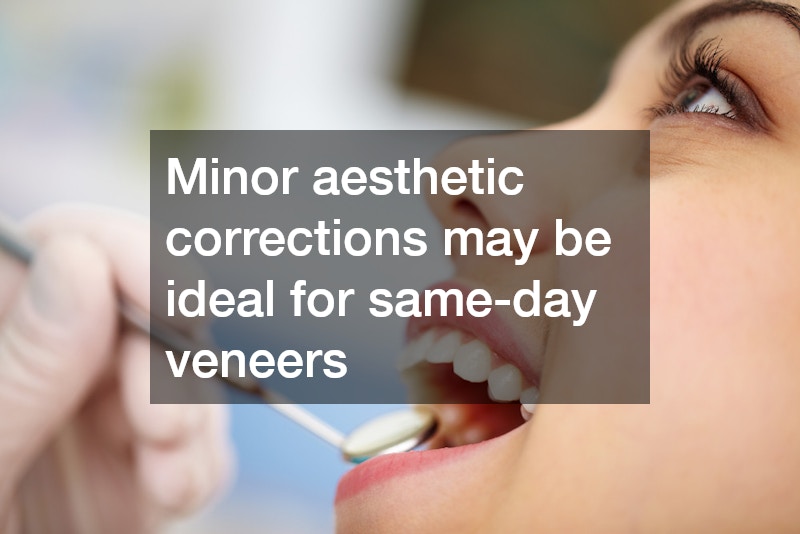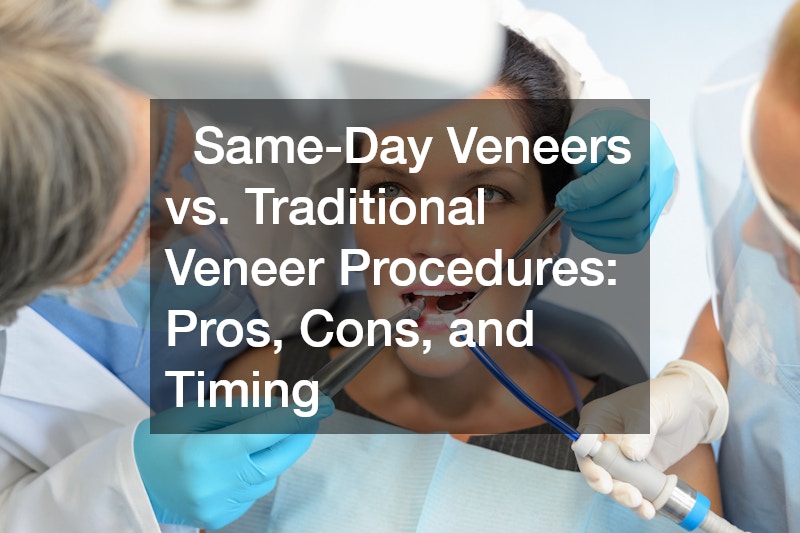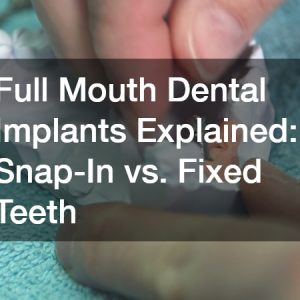-
Veneers can correct discoloration, chips, gaps, and minor misalignments while improving overall smile aesthetics.
-
Traditional veneers offer high customization, superior durability, and are ideal for complex or full-smile makeovers.
-
Same-day veneers provide immediate results in a single visit, with minimal enamel removal and no temporary veneers required.
-
Procedure choice depends on cosmetic goals, dental health, number of teeth, budget, and appointment preferences.
-
Proper maintenance, including brushing, flossing, and regular dental check-ups, is essential for long-term veneer longevity.
-
Consulting with experienced veneers specialists ensures optimal results and a personalized treatment plan.
A radiant, confident smile can greatly enhance your personal and professional life, and dental veneers are among the most popular cosmetic solutions for achieving this transformation. Veneers not only improve the appearance of teeth but can also help protect them from minor wear or damage. However, one of the most common concerns patients have is the time commitment involved in getting veneers. Traditional veneer procedures require multiple appointments over several weeks, while modern same-day veneer technologies allow patients to leave the dentist’s office with a complete smile in a single visit.
Veneers specialists emphasize that the decision between same-day and traditional veneers depends on several factors, including cosmetic goals, dental health, budget, and lifestyle. Each procedure has its advantages and limitations, and understanding these differences is crucial for achieving the best results. This article provides a comprehensive comparison of both approaches, detailing the process, pros and cons, timing, and practical advice to help you make an informed choice.
What Are Dental Veneers?
Dental veneers are ultra-thin shells, typically made of porcelain or composite resin, designed to cover the front surfaces of teeth. They are primarily cosmetic but can also protect teeth from minor damage and uneven wear. Veneers can transform the smile by addressing discoloration, gaps, chips, and irregular shapes, providing a natural, harmonious appearance.
Porcelain veneers are favored for their durability, stain resistance, and natural appearance, often lasting 10–15 years with proper care. Composite veneers, on the other hand, are applied directly to teeth and can usually be completed in a single visit, lasting around 5–7 years. Veneers specialists often recommend porcelain veneers for long-term results or more extensive smile makeovers, while composite veneers are suitable for patients seeking a quick, budget-friendly solution or minor cosmetic corrections.
Common Uses of Veneers
-
Correct discoloration: Mask stains that professional whitening cannot fix, including discoloration caused by medication or enamel defects.
-
Repair chips and cracks: Restore the appearance of minor fractures or worn edges without compromising the tooth’s integrity.
-
Close gaps: Fill small spaces between teeth for a seamless and uniform smile.
-
Adjust shape and alignment: Correct slight misalignments and irregularly shaped teeth without the need for braces.
Veneers specialists stress that the material choice and method of application can significantly affect the procedure’s timing, cost, and durability, making informed consultation essential before treatment.
Traditional Veneer Procedures
Traditional veneers have long been considered the gold standard for cosmetic dental work due to their customizability and durability. This approach involves multiple appointments and collaboration with skilled dental laboratories to ensure the best possible aesthetic outcome.
Step-by-Step Process
-
Initial Consultation and Planning
-
Comprehensive evaluation of teeth and gums to determine suitability.
-
Photographs, X-rays, and digital scans are often taken.
-
Veneers specialists may create mock-ups or temporary trial veneers to preview the final appearance.
-
-
Tooth Preparation
-
A small amount of enamel (0.3–0.5 mm) is removed to accommodate the veneer.
-
Local anesthesia ensures comfort during preparation.
-
Adjacent teeth may be subtly reshaped to optimize aesthetics.
-
-
Temporary Veneers
-
Applied to protect prepared teeth while lab-fabricated veneers are produced.
-
Serve both functional and cosmetic purposes during the waiting period.
-
Temporary veneers may be slightly fragile, requiring careful handling.
-
-
Laboratory Fabrication
-
Impressions are sent to dental labs where skilled technicians craft custom veneers.
-
Materials, color, and translucency are precisely matched to natural teeth.
-
Turnaround typically ranges from 1–3 weeks depending on complexity.
-
-
Final Placement and Adjustments
-
Veneers are bonded using high-quality dental cement.
-
Bite and fit adjustments ensure long-term comfort and stability.
-
Follow-up visits may be scheduled to ensure proper integration.
-
Advantages of Traditional Veneers
-
High level of customization in color, shape, and translucency.
-
Superior durability, particularly with porcelain veneers.
-
Suitable for multiple teeth and complex smile restorations.
-
Achieves a highly natural appearance due to lab craftsmanship.
Drawbacks
-
Multiple visits required over several weeks.
-
Temporary veneers may cause minor discomfort or aesthetic concerns.
-
Higher costs due to lab fabrication and professional expertise.
Tip from veneers specialists: Patients can streamline the process by maintaining excellent oral hygiene, following pre-procedure instructions, and scheduling consultations and appointments efficiently.
Same-Day Veneer Procedures
Same-day veneers, also called chairside veneers, utilize advanced technologies such as CAD/CAM and CEREC systems to design, fabricate, and place veneers in a single visit. These procedures are ideal for patients seeking quick cosmetic results without multiple appointments.
Step-by-Step Process
-
Consultation and Digital Scanning
-
Assessment of teeth, bite, and gums to determine suitability.
-
Intraoral scanners create highly precise digital impressions.
-
3D imaging allows veneers specialists to design veneers virtually for optimal fit and appearance.
-
-
Tooth Preparation
-
Minimal enamel removal is often required.
-
Local anesthesia ensures patient comfort.
-
Adjacent teeth may be subtly adjusted for improved aesthetics.
-
-
Digital Design and Milling
-
Veneers are digitally designed and milled in-office, typically within an hour.
-
Advanced software ensures accurate fit, natural contours, and color matching.
-
-
Placement and Adjustment
-
Veneers are immediately bonded and polished.
-
Bite adjustments are made for comfort and long-term durability.
-
Same-day veneers eliminate the need for temporary solutions.
-
Advantages of Same-Day Veneers
-
Immediate smile transformation in one appointment.
-
No temporary veneers required.
-
Minimally invasive with reduced enamel removal.
-
Ideal for patients with limited cosmetic corrections or busy schedules.
Drawbacks
-
Limited customization compared to lab-fabricated veneers.
-
Less suitable for extensive smile makeovers involving multiple teeth.
-
High-tech equipment may increase costs.
Tip from veneers specialists: While same-day veneers are convenient, complex cases may still benefit from the precision and customization of traditional lab-fabricated veneers.

Pros and Cons Comparison
Traditional Veneers
-
Pros
-
Highly customizable by veneers specialists.
-
Long-lasting durability, especially with porcelain veneers.
-
Suitable for complex cosmetic transformations and multiple teeth.
-
Achieves a natural, aesthetically pleasing appearance.
-
-
Cons
-
Requires multiple appointments over weeks.
-
Temporary veneers may cause minor discomfort or aesthetic compromise.
-
Higher costs due to lab fabrication and professional expertise.
-
Same-Day Veneers
-
Pros
-
One-visit smile transformation.
-
Eliminates temporary veneers and reduces appointments.
-
Minimally invasive with reduced enamel removal.
-
Immediate feedback from veneers specialists on aesthetics and fit.
-
-
Cons
-
Limited customization compared to lab-made veneers.
-
Not ideal for complex full-smile makeovers.
-
Procedure cost may be higher due to advanced equipment.
-
Procedure Timing and Convenience
Timing often plays a critical role in a patient’s decision.
| Aspect | Traditional Veneers | Same-Day Veneers |
|---|---|---|
| Total Appointments | 2–4 | 1 |
| Total Time from Start to Finish | 2–4 weeks | 1 day |
| Temporary Veneers | Often required | Not required |
| Recovery | Minor sensitivity; follow-ups may be needed | Minor sensitivity; follow-ups may be needed |
Tips from veneers specialists:
-
Schedule consultations early to accommodate lab work or digital scans.
-
Maintain good oral hygiene to reduce the risk of complications.
-
Clearly communicate cosmetic goals to ensure optimal results on the first attempt.
Factors to Consider Before Choosing a Procedure
Veneers specialists advise patients to weigh several key factors:
-
Cosmetic Goals: Minor aesthetic corrections may be ideal for same-day veneers, while extensive full-smile makeovers often require traditional veneers.
-
Dental Health: Strong enamel and healthy gums are essential for long-lasting veneers. Existing issues must be addressed first.
-
Budget and Insurance: Traditional veneers often have higher costs due to lab work, while same-day procedures involve high-tech equipment. Insurance coverage may be limited.
-
Number of Teeth: Single-tooth corrections are well-suited to same-day veneers, while multiple teeth may benefit from traditional fabrication.
-
Appointment Preferences: Patients who prefer fewer visits may lean toward same-day veneers, while those prioritizing customization may prefer traditional veneers.
Maintenance and Longevity
Proper care is essential for maximizing the lifespan of veneers, regardless of procedure type.
Daily Care
-
Brush twice daily with non-abrasive toothpaste.
-
Floss carefully to avoid damaging veneer edges.
-
Use a nightguard if you grind your teeth.
Expected Lifespan
-
Porcelain veneers: 10–15 years.
-
Composite veneers: 5–7 years.
Follow-Up Care
-
Schedule dental check-ups every 6–12 months.
-
Minor adjustments or polishing may be required over time.
-
Avoid chewing hard foods or staining substances, and promptly report any chips or cracks to your veneers specialist.
Choosing between same-day and traditional veneers ultimately depends on your cosmetic goals, dental health, budget, and schedule. Traditional veneers offer superior customization and durability, making them ideal for extensive smile makeovers, while same-day veneers provide a quick, minimally invasive option for immediate results.
Veneers specialists emphasize that maintenance, oral hygiene, and regular check-ups are key to long-term success. Consulting a qualified professional ensures a personalized approach that delivers the best aesthetic and functional outcome. Understanding the differences between procedures allows patients to confidently select the option that best meets their needs and lifestyle.



